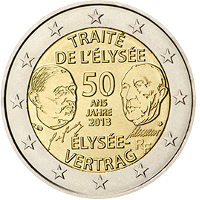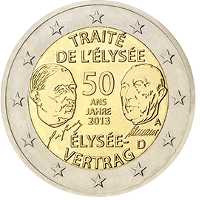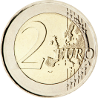 |
C o m m e m o r a t i v e
C o i n s |
||
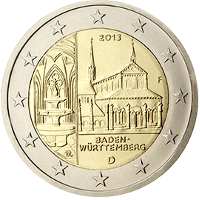 🔎
🔎 |
 |
Germany | 01 Feb. 2013 | Baden‐Württemberg (Maulbronn Monastery) 8th coin in the Federal States series |
20001 20002 20005 |
30,845,000 |  |
‐ ‐ Originally the Heidelberg Castle was intended as the motif for Baden‐Württemberg's commemorative coin, but when the UNESCO World Conference in July 2005 failed to recognise it as a World Heritage Site, the design was changed. |
|||||||
 🔎
🔎 |
 |
Slovenia | 04 Feb. 2013 | 800 years since the discovery of the Postojna Cave |
20001 20002 20005 |
1,000,000 |  |
 🔎
🔎 |
 |
Netherlands | 07 Feb. 2013 | The announcement of the abdiction of the throne by Her Majesty Queen Beatrix |
20001 20002 20005 |
20,000,000 |  |
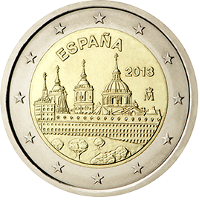 🔎
🔎 |
 |
Spain | 02 Mar. 2013 | Monastery and Site of the El Escorial, Madrid 4th coin in the UNESCO World Heritage Sites series |
20001 20002 20005 |
4,000,000 |  |
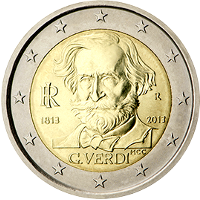 🔎
🔎 |
 |
Italy | 20 May 2013 | 200th birthday of Giuseppe Verdi |
20001 20002 20005 |
10,000,000 |  |
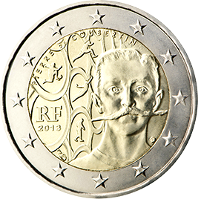 🔎
🔎 |
 |
France | 03 Jun. 2013 | 150th birthday of Pierre de Coubertin |
20001 20002 20005 |
1,014,338 |  |
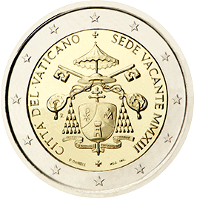 🔎
🔎 |
 |
Vatican City | 03 Jun. 2013 | Sede vacante MMXIII |
20001 20002 20005 |
125,000 |  |
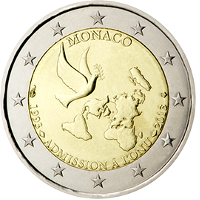 🔎
🔎 |
 |
Monaco | 17 Jun. 2013 | 20th anniversary of its accession to the UN |
20001 20002 20005 |
1,249,131 |  |
 🔎
🔎 |
 |
Portugal | 20 Jun. 2013 | 250th anniversary of the Torre dos Clérigos, Porto |
20001 20002 20005 |
525,000 |  |
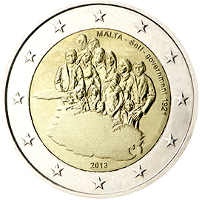 🔎
🔎 |
 |
Malta | 24 Jun. 2013 | Establishment of Self‐Government in 1921 3rd coin of the Constitutional History series |
20001 20002 20005 |
542,500 |  |
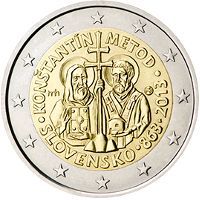 🔎
🔎 |
 |
Slovakia | 05 Jul. 2013 | 1150th anniversary of the advent of the mission of Constantine and Methodius to Great Moravia |
20001 20002 20005 |
1,000,000 |  |
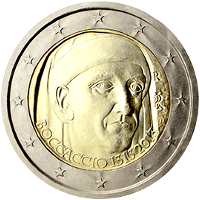 🔎
🔎 |
 |
Italy | 25 Jul. 2013 | 700th birthday of Giovanni Boccaccio |
20001 20002 20005 |
10,000,000 |  |
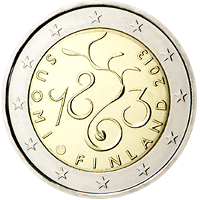 🔎
🔎 |
 |
Finland | 04 Sep. 2013 | 150th anniversary of the Parliament of 1863 when regular Parliament sessions started in Finland |
20001 20002 20005 |
1,000,000 |  |
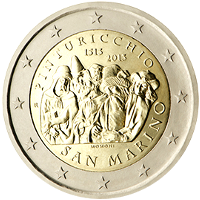 🔎
🔎 |
 |
San Marino | 13 Sep. 2013 | 500th anniversary of the death of Pinturicchio |
20001 20002 20005 |
115,000 |  |
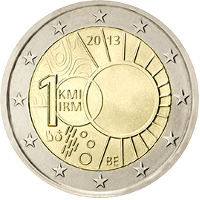 🔎
🔎 |
 |
Belgium | 18 Sep. 2013 | 100th anniversary of the creation of the Royal Meteorological Institute |
20001 20002 20005 |
2,010,000 |  |
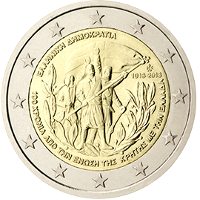 🔎
🔎 |
 |
Greece | 01 Oct. 2013 | 100th anniversary of the union of Crete with Greece |
20001 20002 20005 |
754,000 |  |
 🔎
🔎 |
 |
Greece | 01 Oct. 2013 | 2,400th Anniversary of the founding of Plato’s Academy |
20001 20002 20005 |
754,000 |  |
 🔎
🔎 |
 |
Vatican City | 15 Oct. 2013 | 28th World Youth Day ‐ Rio de Janeiro |
20001 20002 20005 |
115,000 |  |
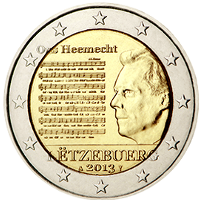 🔎
🔎 |
 |
Luxembourg | 16 Oct. 2013 | National Anthem of the Grand Duchy 11th coin of the Grand-Ducal Dynasty series |
20001 20002 20005 |
522,000 |  |
 🔎
🔎 |
 |
Finland | 04 Nov. 2013 | 125th anniversary of the birth of Nobel Prize-winning author Frans Eemil Sillanpää |
20001 20002 20005 |
1,500,000 |  |
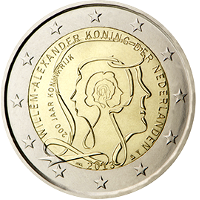 🔎
🔎 |
 |
Netherlands | 25 Nov. 2013 | 200th anniversary of the Kingdom of the Netherlands |
20001 20002 20004 20005 |
3,538,000 |  |
| ⇓ 2014 ⇓ |
| References : | |||
| 20001 | Images taken with authorisation by the ECB - Mail dated 20.Feb.2020 © "European Central Bank" |
20002 | Data mirrored from Wikipedia Page "2_euro_commemorative_coins" with friendly support of the guardians of that page. |
| 20003 | Not Applicable | 20004 | Coloured version of this Commemorative Coin in circulation EU-legal-technical specifications do not recongnise colour prints, but the EU is tolerate them, due to the facts that their numbers are very small and that they are sold in special packs and therefor are very unlikely to be used as currency. |
| 20005 | enlarged Images taken with authorisation by Gerd Seyffert © "Gerd Seyffert 2021" |
20006 | Not Applicable |
 |
